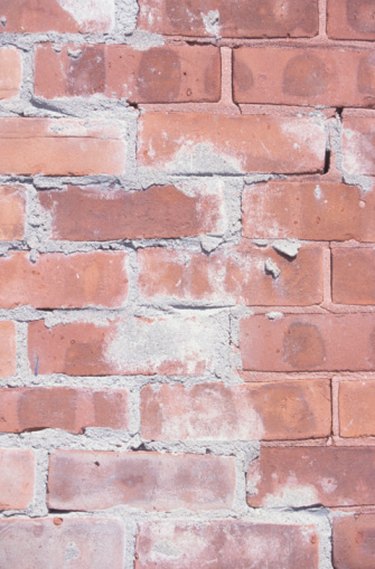Things You'll Need
Grout saw
5-in-1 painter’s tool
Hammer
Stiff-bristled brush
Garden hose with spray nozzle
Mortar
Tuck point trowel
Pointing tool
Damp sponge

Brick-and-mortar exteriors last for many years without needing repairs. Over time, though, water seeps into the mortar joints and begins to wear them away. When enough mortar dissolves, it's time for mortar repair, or brick repointing. You can repoint brick yourself, as long as you match the new mortar mix to the old one. Homes built prior to World War II typically had a lime-based mortar, while newer construction uses Portland cement mortar. If you don't match the original mortar, the mortar repair looks sloppy, and it may cause additional structural damage with the bricks.
Step 1
Determine if you need to use lime-based mortar or Portland-cement. If you aren't sure of the type of mortar, send a small portion off to a reputable dealer who can tell you the exact mix used in the existing mortar as well as help you match the sand. (See Resources)
Video of the Day
Step 2
Use a grout saw to remove old, crumbling mortar from horizontal joints to a depth of at least 3/4 inch. Rake the pointed portion of a 5-in-1 painter's tool into the vertical joints to pull out chunks of old mortar. Tap the opposite side of the pointed end with a hammer to remove stubborn mortar. Use the scraper edge to finish cutting out any remaining mortar in the vertical joints.
Step 3
Clean out all of the dust and debris with a stiff-bristled brush. Use a garden hose to wet the entire area you are repointing. Allow the water to soak into the bricks overnight. This gives the mortar a better chance of curing at the proper speed.
Step 4
Set the spray nozzle on the garden hose to "mist." Lightly dampen the brickwork again.
Step 5
Mix the mortar following package directions. It should be the consistency of peanut butter and should cling to the trowel. Let the mortar set for 15 minutes or until it gets a skin on it. Stir it again, and it's ready to use.
Step 6
Put mortar on a tuck point trowel. Push the mortar into the horizontal joints you are repairing with the trowel. Keep adding mortar until the joint is full. Use a pointing tool to finish the outside of the mortar joint. If you prefer, use your finger. Scrape excess mortar off the brick as you work. Repeat the process with the vertical joints.
Step 7
Brush loose mortar diagonally from the face of the brick wall. If you brush in the direction of the joints, you may wipe away the mortar. If the brush doesn't remove all the excess mortar, use a damp sponge.
Step 8
Mist the wall daily for three days. Keep it covered with a tarp to keep the mortar from drying too quickly and cracking.
Video of the Day